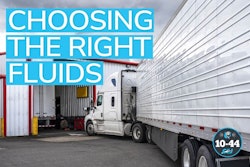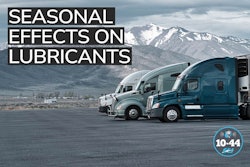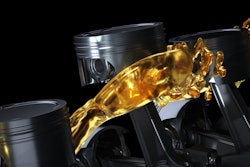If you've ever had to sit and wait for regen or change a diesel particulate filter, you know what a pain ash can be for uptime. But what is it, where does it come from, and in an age where Class 8 trucks can almost drive themselves, why can't we get rid of it?
Joining the 10-44 this week is Keith Shaw, global OEM manager for Chevron Lubricants, and he covers all that and more.
Speaker 1 (00:00):
This week's 10-44 is brought to you by Chevron Delo 600 ADF ultra-low ash diesel engine oil. It's time to kick some ash.
Speaker 2 (00:09):
What is all that ash that accumulates in your DPF, and how can you prevent it or at least minimize it?
Speaker 3 (00:15):
You're watching CCJ's 10-44, a weekly episode that brings you the latest trucking industry news and updates from the editors of CCJ. Don't forget to subscribe and hit the bell for notifications, so you'll never miss an installment of 10-44.
Speaker 2 (00:30):
Hey, everybody, welcome back. I'm Jason Cannon and my co-host on the other side is Matt Cole. The diesel particulate filter doesn't really require a lot of direct maintenance on a regular schedule. It just requires some basic monitoring before a regularly scheduled cleaning or change. The stuff getting trapped inside that filter is basically just uncombusted particles from the fuel, the air, and the engine oil.
Speaker 4 (00:51):
Manufacturers of diesel fuel have for close to 20 years, been producing ultra-low sulfur diesel fuel, and engine oil companies weren't far behind with low ash engine oils for the 2010 model year. In 2019, Chevron lubricants doubled down with its ultra-low ash formulation.
Speaker 2 (01:06):
Joining the 10-44 this week is Chevron lubricants global OEM manager, Keith Shaw. And he says, "First, it's important to recognize the distinction between low ash and ultra-low ash diesel engine oils because just about everything you can buy these days is at least low ash."
Speaker 5 (01:23):
The term low ash came into play when API launched CJ-4. And when they launched CJ-4 designation, that was the first time the category had a sulfated ash limit, and that was 1%. So, that was a maximum that you could have. You could have less, but the maximum was 1%, and of course, as continued on with CK-4. And the focus on that was really the after treatment system because the aftertreatment system, the [inaudible 00:01:55] DPF, et cetera, just does not like ash. And we've talked about this before. The ash is that junk that you have to clean out of the DPF periodically.
(02:04):
Chevron took a look at a new development on what we term as ultra-low ash, so, that's really about half the percent of ash. So, our Delo 600 ADF is 0.4 versus the maximum level of one. And so, when you look at oils today, you pick up an API CK-4 oil. Typically, it's not going to say, "Oh, this is a 1% ash oil anywhere." You may see that on the product data sheet, but you probably won't see it on the label because by proxy, all API CK-4s are maximum 1%, and that's where everyone designs for.
(02:37):
But no one's really formulating the ultra-low ash space such as Chevron is, and part of that and you say, "Well, why doesn't everyone do it?" Because one's the limit, but you could certainly have 0.5, 0.4 or zero if you wanted. And the reason is because it's a significant investment in time, and it's a completely different paradigm shift in the additives that get used. And we started this journey, Chevron did on the ultra-low ash technology about 15 years ago. And this was taken up in addition to all the other formulation we work on traditional 1% ash formulations.
Speaker 4 (03:20):
Keith mentioned that in theory, you could get to zero ash with an engine oil formulation. So, why doesn't everyone just use a formulation that removes ash entirely? Keith says it's hard and potential benefits don't measure up to the drawbacks. He tells us more after word from 10-44 sponsor, Chevron lubricants.
Speaker 1 (03:37):
Protecting your diesel engine and its after treatment system has traditionally been a double-edged sword. The same engine oil that is so essential to protecting your engine's internal parts is also responsible for 90% of the ash that is clogging up your DPF and upping your fuel and maintenance costs.
(03:51):
Outdated industry thinking still sees a trade-off between engine and emission system protection and Chevron was tired of it, so they spent a decade of R&D developing a no compromised formulation. Chevron lubricants developed a new ultra-low ash diesel engine oil that is specifically designed to combat DPF ash clogging.
(04:10):
DelO 600 ADF with omnimax technology cut sulfate ash by whopping 60%, which reduces the rate of DPF clogging and extends DPF service life by two and a half times. And just think what you can do with all the MPGs you're going to add from cutting your number of regions. But Delo 600 ADF isn't just about after treatment. It provides complete protection extending drain intervals by preventing oil breakdown before you had to choose between protecting your engine or your aftertreatment system and now, you don't. 600 ADF from Delo with omnimax technology, it's time to kick some ash.
Speaker 5 (04:44):
We gave it a really solid try, and when we were formulating the concept of this ultra-low ash formulation and how low could we go, we also had to be cognizant that we talk about API or even the OEM approvals. But a CK-4 today, an API CK-4 oil today has to pass nine different engine bench tests. Each one of these tests is designed to stress the oil in a different way. It could be such versus the valvetrain where piston deposits wear control, oil oxidation, aeration, et cetera.
(05:18):
And so, the tests are so severe, and they also pick up tests from previous categories because of course, heavy trucks are out there on the road 12, 15 years or longer. You have to have backwards compatibility. So, while we tested formulations with zero ash and used a lot of ash list form additives in that testing, we could pass some tests. We just couldn't pass a lot of testing. And quite honestly, a lot of it was a legacy test. And so, you can't launch a zero ash oil and say, "Well, it's only good for 2020 engines and above." I mean, it just doesn't satisfy any fleet, doesn't do anybody any good. So, we've tried it. We think it's very, very challenging to end up with a zero ash formulation in today's world where you not only have to meet API qualifications, but as you know, OEMs, a Detroit diesel, a Volvo, Cummins have their own specifications that you also have to meet.
(06:19):
A lot of times those are more engine tests, and certainly, we have to have it applicable for the European OEMs as well. We'll continue this process and ultimately maybe that's it, but again, I'm sure a lot of people listening, they're operating over a lot of mixed operating conditions, whether it's long haul, regional, local, urban, or even vocational. So, coming up with a single formulation that satisfies all the OEMs, all the industry requirements, all the operating conditions, it's really difficult without some ash.
Speaker 2 (06:58):
One of the things that we hear a lot from fleets and drivers with regard to engine oil is that they like to run what they've always run, and maybe that's what their grandfather ran. And that makes getting newer and other solutions like synthetics or synthetic blends into the hands of the end user pretty tricky. But Keith points out that newer solutions aren't always better ones under every given condition.
Speaker 5 (07:18):
If you're stuck on, well, I only want to use my mineral oils and I want to keep on my 1540, that's fine. What you're given up though is you're given up a lot, especially with these newer engines. Your chance for extending oil drain intervals, your increasing deposits, increasing sludge, and probably more so you're giving up those oil drains and performance characteristics that you want from the synthetic fluids.
(07:48):
The tradeoff is mineral oils have their place too. When you look at an engine and if you look at the lubrication regimes or challenges, you've got everything from your valvetrain, which is really operating in a boundary type lubrication regime there, and that's really metal to metal contact a lot. So, you really have to have certain additives and you want the base oil kind of a little thicker if you will. As you get to pistons and bearings, you start getting to mix to hydrodynamic and you want really your fluid film carries a lot of that.
(08:22):
So, you've got a lot of things going on in that engine. Different requirements for what you want on the lubricant. And in today's modern engines with the higher temperatures and what you're seeing in that, you want some of that synthetic fluid in there. And what we found is that the synthetic blends and a lot of cases are a better option even in full synthetics because you have those mixed regimes that you need. And sometimes, that neuro oil really is good, right? And that's what you need, but you need that focus on the synthetic blends, which Stella 600 is one.
Speaker 4 (08:59):
A complicating factor for engine oil selection for fleets is the diversity of fuels we're going to see moving forward especially as fleets start to mix fuel types in the march toward reduced and zero emissions.
Speaker 5 (09:10):
What we've heard from our customers for years is, "Why in the world do I have to use two oils?" And when I have a mixed fleet operation, these oils are going to get mixed back and forth. And it's the same as true as I don't want to use diesel engine oil that's only approved for diesel engine, my gas engine. Well, I certainly don't want to use my gas engine oil and my diesel engine, because then, I'm going to be missing things I need.
(09:35):
So, really Chevron's point of view on this whole ultra-low ash technology has been, can we get to a fuel agnostic lubricant to simplify the end user's experience and choices and reduce complexity because this is not going to stop. You're seeing more increases in demands for biodiesels. We're seeing more increase demands for things like hydrogen ICE. We're working with several OEMs today on hydrogen internal combustion engines, and we're using the Delo 600 ADF for those applications as well as methanol. So, a lot of OEMs are looking at different fluids that can lower the carbon intensity and carbon footprint, but still be able to provide the end user with something they're familiar with, which is an internal combustion engine.
Speaker 1 (10:30):
That's it for this week's 10-44. You can read more on ccjdigital.com. While you're there, sign up for our newsletter and stay up to date on the latest in trucking industry news and trends.
(10:40):
If you have any questions or feedback, please let us know in the comments below. Don't forget to subscribe and hit the bell for notifications, so you can catch us again next week.











